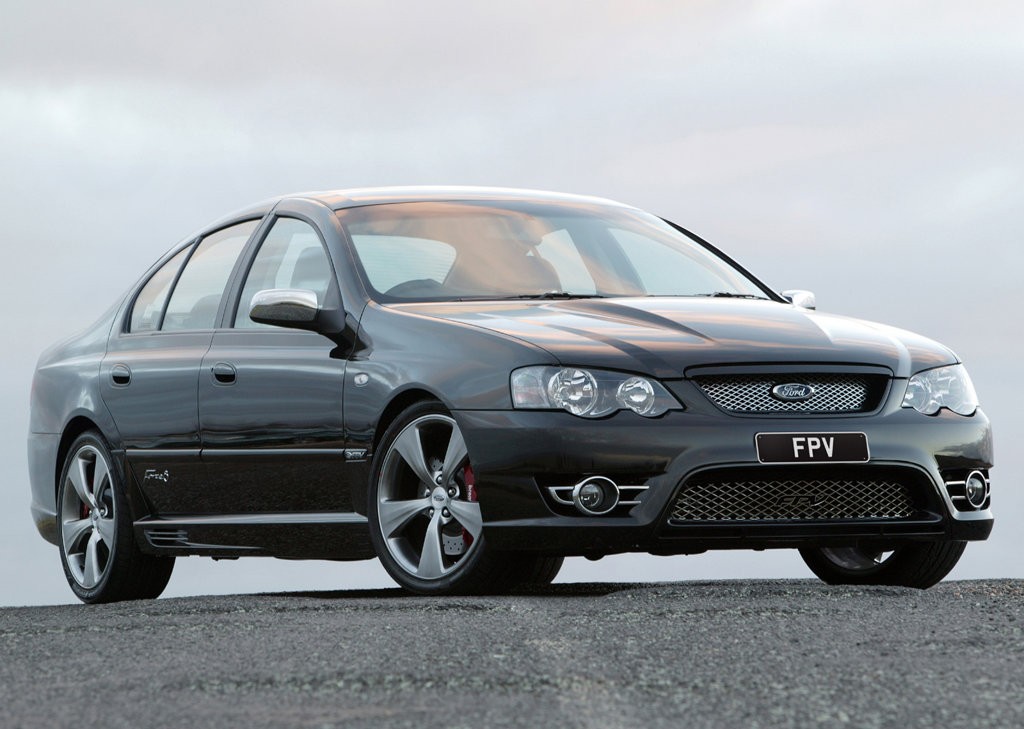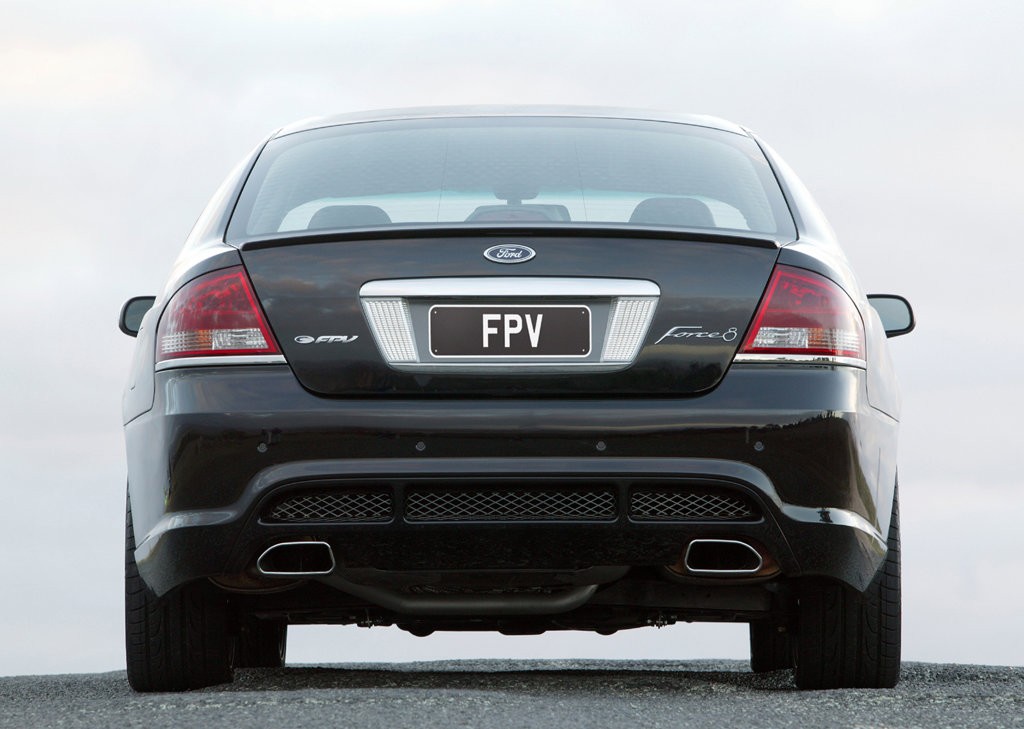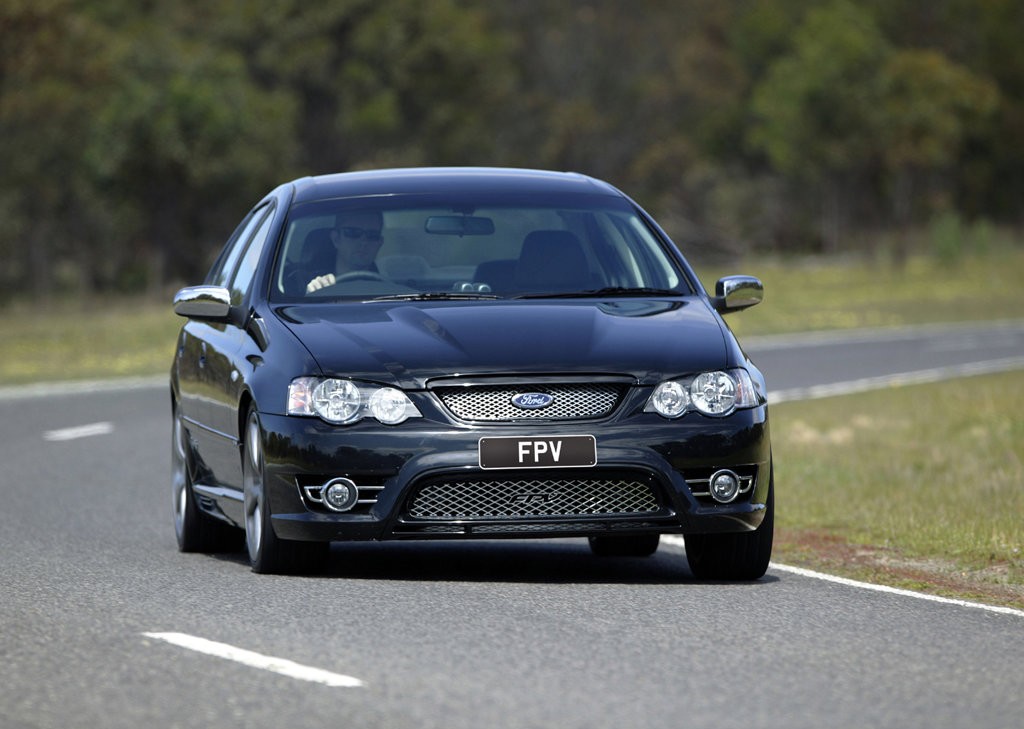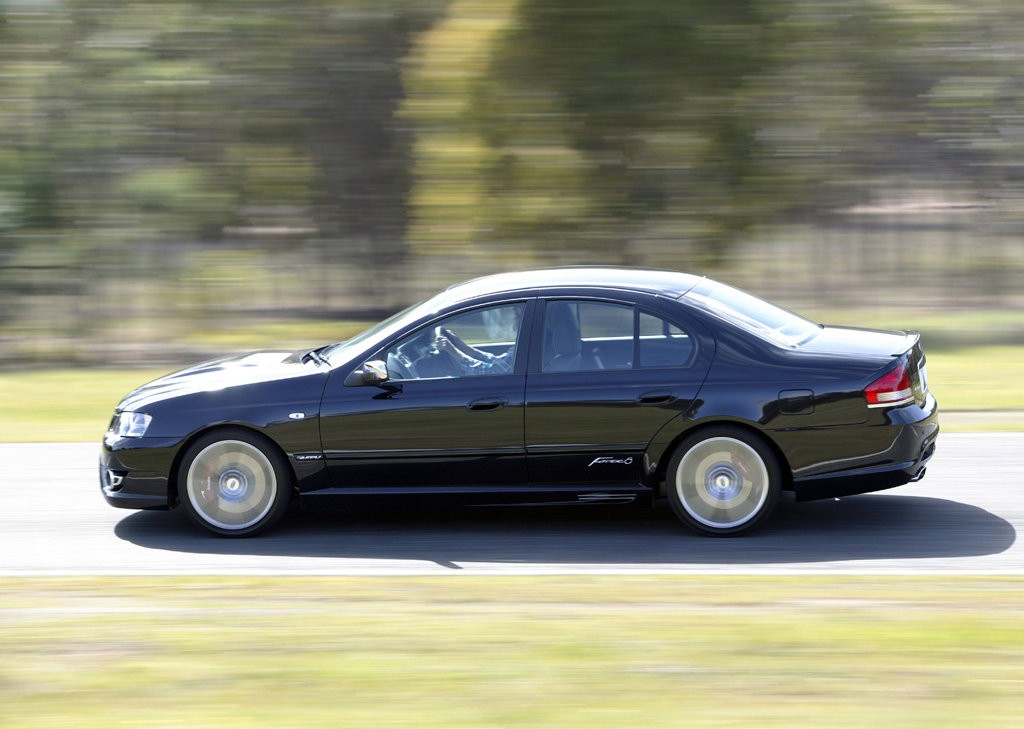
- Powerful ‘Boss 290’ and ‘Boss 302’ V8 engines
- Impressive ride/handling balance
- Refined six-speed ZF automatic transmission
- Accurate, well-weighted steering
- Powerful Brembo brakes
- For ZF transmission, coolant lines in heat exchanger were susceptible to failure
- No curtain airbags or electronic stability control
- Prone to drivetrain clunks
- ‘Control Blade’ semi-trailing arm rear suspension inferior to VE Commodore-based four-link IRS
Review: FPV BF.II Force 8 (2006-08)
Overview
Released in October 2006, the FPV BF Mk.II (BF.II) Force 8 was a rear-wheel drive, performance sedan. Manufactured in Campbellfield, Victoria, the Force 8 was powered by 5.4-litre ‘Boss 290’ V8 petrol engines that were mated to six-speed automatic transmissions. Compared to the FPV BF GT on which it was based, the Force 8 had a greater emphasis on luxury features and was released in conjunction with the similarly-equipped FPV BF Force 6 .
Boss 290 and Boss 302 engines
Assembled by hand in Campbellfield, the 5.4-litre Boss 290 V8 engine had a cast iron block, cast aluminium cylinder head (shared with the Mustang Cobra R), forged steel crankshaft, cross-bolted main bearing caps, sintered connecting rods, double overhead camshafts (DOHC) per cylinder bank, roller finger followers, four valves per cylinder, twin knock sensors, an alloy inlet manifold, coil on plug ignition and a compression ratio of 10.5:1.
In November 2007, the Boss 302 V8 engine was introduced. Compared to the Boss 290, changes for the Boss 302 engine included:
- New inlet and exhaust camshaft profile to increase inlet valve lift and duration (necessitating new valves and valve springs);
- A higher compression of 10.8:1 (previously 10.5:1)
- Stainless steel fabricated exhaust manifolds;
- High-flow dual exhaust system; and,
- A revised engine calibration.
ZF 6HP26 Transmission
The BF Force 8 was offered with the six-speed ZF 6HP26 automatic transmission. Like the GT and GT-P, the Force 8 was fitted with the high-performance version of this transmission – which had upgraded clutches with extra plates in the clutch packs – and a torque capacity of 600 Nm.
The ZF 6HP26 transmission featured adaptive ‘Driver Recognition’ behaviour, including brake support downshifts, gear holding when cornering, gear holding for uphill and downhill driving and gear holding for fast-off throttle driving situations. Furthermore, the ZF 6HP26 transmission had a remote transmission oil cooler (RTOC) – with a three-way coolant thermostat – that was mounted to the engine block. Acting as a heat exchanger, coolant lines (or tubes) passed through the radiator to warm-up the transmission fluid on start-up and provide cooling under high load/high temperature operating conditions.
For the BF range, ‘transient rpm’ limits were introduced which enabled the engine to momentarily exceed the prescribed rev limit of 6000 rpm during upshifting by 250 rpm (i.e. to 6250 rpm). This enabled wide open throttle upshifting of gears to be scheduled at an engine speed closer to the rev limiter than would otherwise be possible.
Dimensions
The FPV BF Force 8 was 4917 mm long, 1870 mm wide, 1444 mm tall and had 2829 mm long wheelbases.
Suspension
The FPV Force 8 had double wishbone front suspension, while the independent rear suspension (IRS) had three control arms:
- A forged upper control arm;
- A stamped front lower control arm; and,
- A stamped rear lower control arm.
Each control arm had a cross axis ball joint on the wheel assembly end and was attached to the subframe and knuckle. Furthermore, the ‘Control Blade’ was a stamped trailing arm which provided lateral support and acted as a vertical pivot point.
| Engine | Trans. | Years | Peak power | Peak torque | |
|---|---|---|---|---|---|
| Force 8 | 5.4-litre Boss 290 petrol V8 | 6sp auto | 2006-07 | 290 kW at 5500 rpm | 520 Nm at 4500 rpm |
| 5.4-litre Boss 302 petrol V8 | 6sp auto | 2007-08 | 302 kW at 6000 rpm | 540 Nm at 4750 rpm |
Safety equipment
Standard safety equipment for the FPV Force 8 included dual front airbags, front side airbags, ABS, electronic brake force distribution, traction control and front seatbelts with pretensioners and load limiters.
Brakes
The FPV Force 8 had 355 mm by 32 mm cross-drilled and slotted front brake discs with four-piston Brembo calipers and 330 mm by 28 mm cross-drilled rear discs with single piston calipers.
The optional, extra-cost ‘Premium’ braking package differed in that it had Brembo six-piston front calipers and 330 mm by 28 mm cross-drilled rear discs with Brembo four-piston calipers.
Features
Like the FPV BF GT , standard features for the FPV Force 8 included a 150 watt sound system with six speakers, a subwoofer and a six-disc CD player, dual-zone climate control air conditioning, cruise control, a TFT colour display, front fog lamps, automatic headlights, split and folding rear seats, remote central locking, power mirrors and windows, a tilt and reach adjustable steering wheel, trip computer and an immobiliser. The Force 8, however, was distinguished by its 19-inch shadow chrome alloy wheels, Regency Red or Dark Charcoal leather seats, an eight-way power adjustable driver’s seat with memory settings, rear parking sensors and woodgrain interior trim.
The Force 8 was also fitted with a limited slip differential.
Related links
- Specifications: FPV BF.II Force 6 and BF.II Force 8 (November 2006)
- Ford Newsroom: A new Force in luxury performance (March 2007)
- Wikipedia.org: FPV BF.II Range






